Is Hook Kick training really worth it? Isn't it one of the weaker kicks?
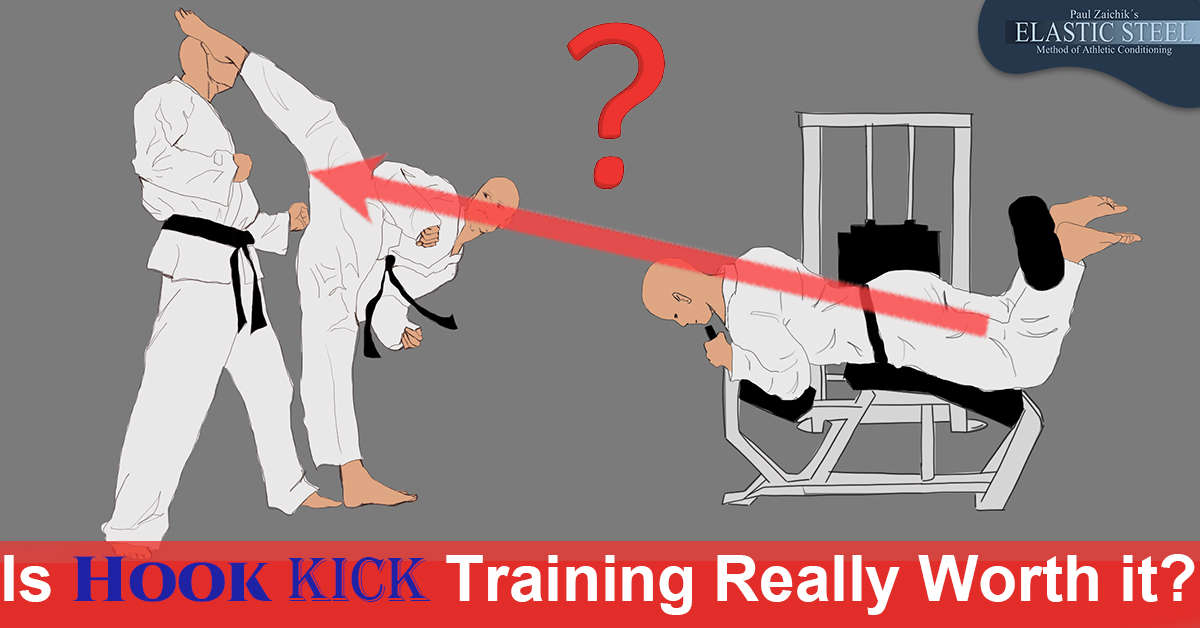
Is Hook Kick training really worth it? Isn't it one of the weaker kicks?
I got this question enough times, to decide to write an article about it. Now. If you are a martial artist who has been in kicking arts for a while, you probably held a pad for other people while they threw different kicks. And if you compare the basic kicks; the power of a Side Kick, Front Kick, Roundhouse and Hook kick. And you had to pick which one is the weakest. You would probably say the hook kick.
Now we're talking about front leg kicks. We're not talking about rear leg kicks or spinning kicks or jump kicks, or kicks with various steps. And of course, rear leg front kick, or rear leg roundhouse, or spinning back kick would add value to the basics, just as the spinning hook kick would add more force to the hook kick. But we're talking about basic kicks. And when I say value, I mean more force to each of those kicks I just mentioned.
Now we're talking about front leg kicks. We're not talking about rear leg kicks or spinning kicks or jump kicks, or kicks with various steps. And of course, rear leg front kick, or rear leg roundhouse, or spinning back kick would add value to the basics, just as the spinning hook kick would add more force to the hook kick. But we're talking about basic kicks. And when I say value, I mean more force to each of those kicks I just mentioned.
Nowadays, there's a prevalent notion of drawing comparisons between various kicks and leg training like squats, leg extensions, and leg curls.
So several times over the years, people have said to me: "My squat is a lot stronger than my other leg training techniques. And my leg extension on the machine is not as strong as my squat, but it's stronger than my leg curl."
The reason that they say this, is because, of a very simple and straightforward comparison. With the assumption that the side kick should be stronger because it's like a squat and leg extension is like a roundhouse kick, and leg curl on a machine is like a hook kick.
The reason that they say this, is because, of a very simple and straightforward comparison. With the assumption that the side kick should be stronger because it's like a squat and leg extension is like a roundhouse kick, and leg curl on a machine is like a hook kick.
And while strength training does help, I myself have witnessed this, and maybe you saw this as well. Where, there could be two guys, one bench pressing a lot more than the other one. But when they throw a punch, the one that bench presses less has a stronger punch.
I used to workout with someone who had incredibly strong leg press. He was able to leg press a lot more weight than others could. And if, in theory, leg press resembles a push front kick, he should have had a stronger kick. He was taller, bigger, heavier than I was. And he was leg pressing a lot more than I was. But, I had a stronger front kick.
So, with this understanding, just because someone can't lift as much weight with a leg curl while on a curl machine, as much as leg extension or leg press, or a squat or a lunge. Doesn't necessarily mean that their hook kick is not going to be an effective kick from the point of power.
I used to workout with someone who had incredibly strong leg press. He was able to leg press a lot more weight than others could. And if, in theory, leg press resembles a push front kick, he should have had a stronger kick. He was taller, bigger, heavier than I was. And he was leg pressing a lot more than I was. But, I had a stronger front kick.
So, with this understanding, just because someone can't lift as much weight with a leg curl while on a curl machine, as much as leg extension or leg press, or a squat or a lunge. Doesn't necessarily mean that their hook kick is not going to be an effective kick from the point of power.
A kick just like a punch, just like a throw of a ball, is a
biomechanical chain. It is not the strength of one muscle.
biomechanical chain. It is not the strength of one muscle.
A kick just like a punch, just like a throw of a ball, is a biomechanical chain. It is not the strength of one muscle. In other words, you're not lying down on the floor, placing someone's head where your foot would be when you were to do a leg curl and trying to do a leg curl on the floor, while all the other parts of your body are completely stable and not moving, and trying to see if you can knock somebody out by doing a leg curl.
That's not what a hook kick is. But for a lot of beginners, especially people who had a little bit of weight training and start martial arts, it seems that there is that strong association.
I have to underline this very important fact again. Having strength is absolutely important, but strength is also very specific. There is transfer over between various skills, of course, and, certain strength training skills transfer better into martial arts than others. However, proper biomechanics of the kick. Proper motor learning of the kick. The breathing. The visualization of the body. Awareness. All these things play a large role.
As well as the balance, the coordination, the strength to support yourself on one leg and flexibility. The strength and flexibility of your trunk. How light your kicking leg is because of the strength of the abductors and also other factors play a role. It's not just the strength of a muscle that is perceived to deliver the kick. In the biomechanical chain of a kick there are many muscles that accelerate the kick, and those are extremely important, not just the muscle that delivers the kick.
I have to underline this very important fact again. Having strength is absolutely important, but strength is also very specific. There is transfer over between various skills, of course, and, certain strength training skills transfer better into martial arts than others. However, proper biomechanics of the kick. Proper motor learning of the kick. The breathing. The visualization of the body. Awareness. All these things play a large role.
As well as the balance, the coordination, the strength to support yourself on one leg and flexibility. The strength and flexibility of your trunk. How light your kicking leg is because of the strength of the abductors and also other factors play a role. It's not just the strength of a muscle that is perceived to deliver the kick. In the biomechanical chain of a kick there are many muscles that accelerate the kick, and those are extremely important, not just the muscle that delivers the kick.
You don't freeze your hip and just move the knee. If a kick is done that way, it's not going to have a lot of power.
And speaking of the whole kick, it's not a leg kick per se, because there is movement of the hip also, not just the knee. You don't freeze your hip and just move the knee. If a kick is done that way, it's not going to have a lot of power.
The same way as the roundhouse, if you lift the chamber and you just extend the knee and you don't accelerate your body with a proper line of force into the target, you're not going to get much force. You might have the strongest quadricep, and you might even be able to push somebody with that kick, but you're not going to accelerate the force that you need, to do what you want to do with a kick, which is basically penetrating the target instead of just pushing the target.
The same way as the roundhouse, if you lift the chamber and you just extend the knee and you don't accelerate your body with a proper line of force into the target, you're not going to get much force. You might have the strongest quadricep, and you might even be able to push somebody with that kick, but you're not going to accelerate the force that you need, to do what you want to do with a kick, which is basically penetrating the target instead of just pushing the target.
If I have very strong hamstrings, does that not matter? Won't it help me to deliver a stronger hook kick?
So as you read this, you probably have a question: "If I have very strong
hamstrings, does that not matter? Won't it help me to deliver a stronger hook
kick?"
If you properly use the strength of your hamstrings, it will allow you to deliver a stronger hook kick. If you improperly use the strength of your hamstrings, it will matter very little.
hamstrings, does that not matter? Won't it help me to deliver a stronger hook
kick?"
If you properly use the strength of your hamstrings, it will allow you to deliver a stronger hook kick. If you improperly use the strength of your hamstrings, it will matter very little.
How useful is a Hook Kick?
Now about the usefulness of the hook kick. You can use it, you don't have to use it. There are people who do just fine with a front kick or roundhouse and sidekick, or just a roundhouse, or just sidekick.
But having a hook kick in your arsenal gives you more options. Sometimes just like a roundhouse it may not knock a person out, but it could force them to move a certain way, force them to move their hands, to move their body, to get out of balance, maybe distract them, maybe even hurt them a little bit where other techniques can go in, where before you were not able to do that.
But having a hook kick in your arsenal gives you more options. Sometimes just like a roundhouse it may not knock a person out, but it could force them to move a certain way, force them to move their hands, to move their body, to get out of balance, maybe distract them, maybe even hurt them a little bit where other techniques can go in, where before you were not able to do that.
So sometimes there's an opening that is perfect for a hook kick that you can't get to with a roundhouse. You can't get it with a sidekick, you can't get it with an Axe Kick, but it's perfect for a hook kick. If you are there just to score a point, you might get a point. If you're there to knock someone down or out you might use a hook kick to successfully start your attack and then finish with whatever other techniques that you want.
I have seen people go down from a regular front kick hook kick. Of course, if you add a spin to it and make it a spinning hook kick or jump spinning hook kick, it
becomes a stronger kick. And YouTube is filled with videos of people getting
knocked out with those kicks.
I have seen people go down from a regular front kick hook kick. Of course, if you add a spin to it and make it a spinning hook kick or jump spinning hook kick, it
becomes a stronger kick. And YouTube is filled with videos of people getting
knocked out with those kicks.
HOOK KICK POWERPOWER DEVELOPMENT
HOOK KICK: POWER DEVELOPMENT
This program teaches you how to add power to the hook kick.
Over the years many students and instructors have asked for a program to develop a powerful hook kick. It’s quite rare to see a hook kick knockout. More with spinning hook, than lead leg hook kick actually.
Many full contact fighters who have a fast and well timed hook kick usually abandon using it in fighting. The reason for that is because landing a hook kick, without doing damage puts the kicker into a difficult position. That is because the body turns into the opposite direction of the kick. You can check this mechanical concept for yourself:
Many full contact fighters who have a fast and well timed hook kick usually abandon using it in fighting. The reason for that is because landing a hook kick, without doing damage puts the kicker into a difficult position. That is because the body turns into the opposite direction of the kick. You can check this mechanical concept for yourself:
When you throw a Hook Kick, doesn't it expose your back if it gets blocked?
I once got a question about the Hook Kick and the question went something like this. "When you throw a Hook Kick, doesn't it expose your back if it gets blocked?"
In other words, someone threw the hook kick, you blocked it, and now if you move the leg back where it came from, the person's back is exposed to you.
In other words, someone threw the hook kick, you blocked it, and now if you move the leg back where it came from, the person's back is exposed to you.
The answer is it depends, that could happen. But if a person is throwing a hook kick in such a way that his body is properly aligned and not turn with his
back to his opponent, it's very easy to recover from that kick.
And if you have good strength and control in your whole body, not just your kicking leg, but also your torso and your supporting leg. It's not going to be very easy for someone to just smack your leg out of the way, and make you turn around. So it depends how good you are with that kick. And also if you are sparring for points where you're not looking to hit hard.
I noticed this, that a lot of people are much better at blocking a roundhouse kick or even a side kick, than a hook kick. And the hook kick is an excellent technique to use while faking with a roundhouse or faking with a sidekick. It very frequently gets to the target when it's done that way. Not all the time, of course, but very
frequently.
So, in conclusion, whether it's worth it to put your effort and energy into developing your hook kick or just focusing on other kicks. It's a good addition to your arsenal, but it depends on the amount of time you have on your strategy and it's a decision that everyone should make for themselves. If you're looking for a hook kick program we've got one! And if you have any questions that you need answered feel free to connect!
back to his opponent, it's very easy to recover from that kick.
And if you have good strength and control in your whole body, not just your kicking leg, but also your torso and your supporting leg. It's not going to be very easy for someone to just smack your leg out of the way, and make you turn around. So it depends how good you are with that kick. And also if you are sparring for points where you're not looking to hit hard.
I noticed this, that a lot of people are much better at blocking a roundhouse kick or even a side kick, than a hook kick. And the hook kick is an excellent technique to use while faking with a roundhouse or faking with a sidekick. It very frequently gets to the target when it's done that way. Not all the time, of course, but very
frequently.
So, in conclusion, whether it's worth it to put your effort and energy into developing your hook kick or just focusing on other kicks. It's a good addition to your arsenal, but it depends on the amount of time you have on your strategy and it's a decision that everyone should make for themselves. If you're looking for a hook kick program we've got one! And if you have any questions that you need answered feel free to connect!
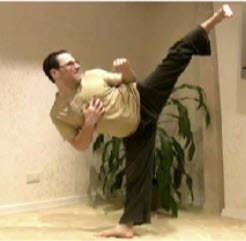
About the Author:
Paul Zaichik is an Exercise Science Expert, author of multitude of books, and the creator of Zaichik Stretching Technique (formely known as Kinesiological Stretching Technique). His speciality is flexibility training as well as body weight conditioning. His innovative method is designed to have maximum carry over into specific athletic techniques. Paul is the author of books and DVD’s on the topic of flexibility, martial arts and bodyweight training. Over the years, Paul Zaichik has worked with a variety of individuals including athletes, entertainers, and military personnel. His ElasticSteel Method of Athletic Conditioning programs, EasyFlexibility Programs and Zaichik Stretching Techniques are used world wide by both professional and amateurs with great success.
YOU MAY ALSO BE INTERESTED IN
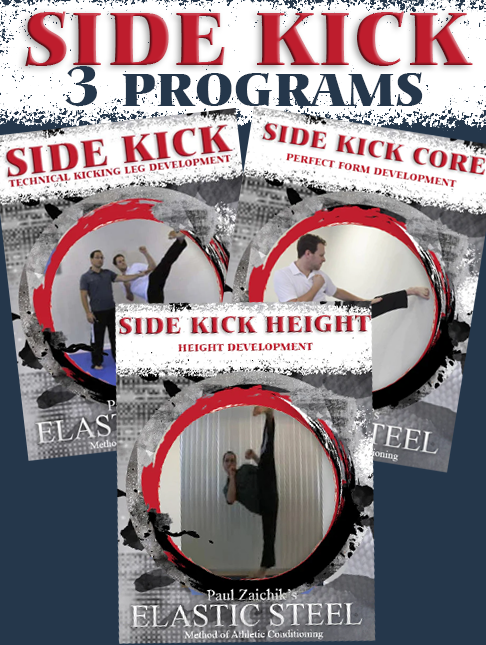
3 Program
Side Kick Combo
Side Kick Combo
This combo includes:
- Technical Kicking Leg Development
- Core Flexibility & Strength Development
- Height Development

7 Program
Side Kick Combo
Side Kick Combo
This combo includes:
- Technical Kicking Leg Development
- Core Flexibility & Strength Development
- Height Development
- Speed Development
- Precision & Accuracy Development
- Power Development
- Flying Side Kick
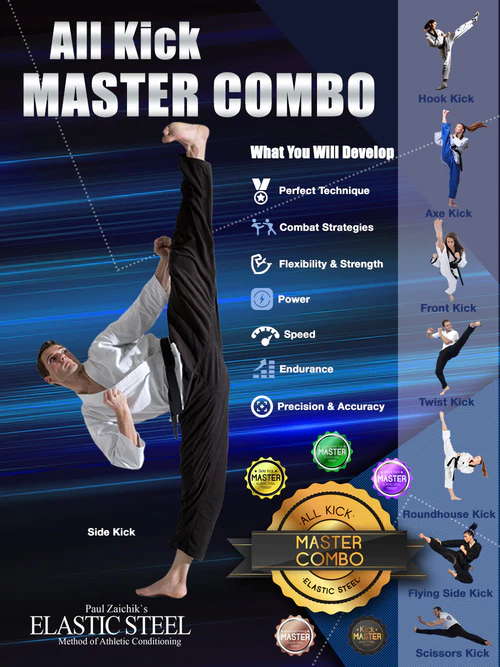
20 Program
All Kick Master Combo
+ 5 Gifts!
All Kick Master Combo
+ 5 Gifts!
This combo includes:
Side Kick:
- Technical Kicking Leg Development
- Core Flexibility & Strength Development
- Height Development
- Speed Development
- Precision & Accuracy Development
- Power Development
- Neutralizing Opponents Defense and Guard Penetration Set Ups
Roundhouse and Hook Kicks:
- Roundhouse Kick: Technical Kicking Leg Development
- Roundhouse Kick: Speed Development
- Roundhouse Kick: Power Development
- Hook Kick: Power Development
Front Kick:
- Front Kick and Front Line Kicks: Technical Kicking Leg Development
- Front Kick: Speed Development
- Push Front Kick: Power Development
- Axe Kick: Power Development
- Ball of the Foot: Point of Impact
Advanced Kicks:
- Scorpion Kick: Perfect form Development
- Flying Side Kick: Technique and Jumping Height Development
- Flying Split Scissors Kick, Two Direction Kick
- Twist Kick Technical Kicking Leg Development
- Twist Kick Follow Along Routine
+ 5 GIFTS!

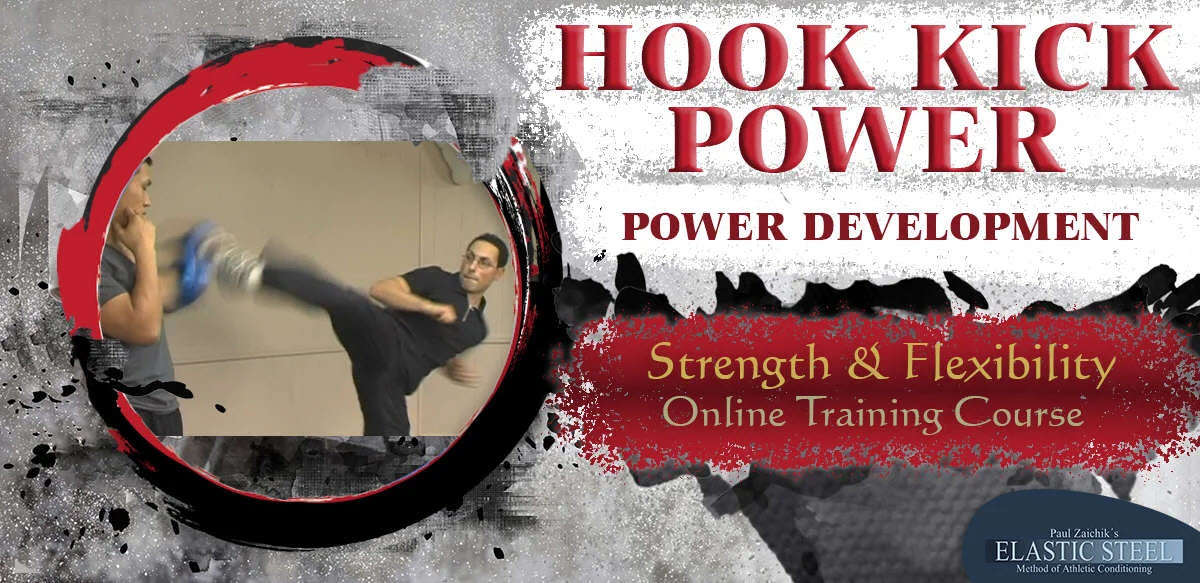
Leave a comment